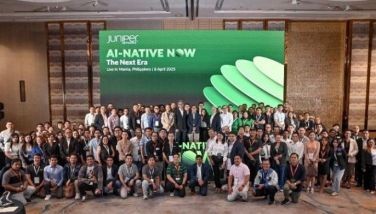The tree of life may solve our fuel problem
March 16, 2002 | 12:00am
In local Christian lore, the coconut is the Tree of Life that God planted along with the Tree of Knowledge in the Garden of Eden. But the finest tribute to the coconut is the oriental legend of its origin. In that legend, an astrologer tells the king, "Anything that you plant today will grow into the most useful tree for mankind."
"Anything?" the king asked.
"Anything," the astrologer assured.
The king despised the astrologer because he had accurately predicted many great calamities. So he planted the astrologer’s head. Wonder of wonders, the coconut tree grew! That is why some wiseacres refer to the coconut as "the nut that held its ground."
The two lores disagreed on how, where and when the coconut originated. But both agreed that it is the Tree of Plenty. Among the benefits that households get from the coconut are: oil, milk, wine, liquor, vinegar, timber, terminal-bud cabbage, locally called ubod, charcoal, floor polisher, thatch mats, bowls and brooms.
During World War II, doctors in the South Pacific discovered two additional uses for the coconut. First, was that in an emergency, coconut water could substitute for blood plasma. Second, that surgical incisions sewn with coconut coir healed faster than those stitched with catgut. In Hawaii, coconut cabbage is called …Millionaire’s Salad. This is because the tree dies when you remove its terminal bud. So you have to pay for a whole tree. In the Philippines, lumpiang ubod is a fairly common fare.
The most ironic part about the coconut is its very name – coco. Early Portuguese explorers gave it that name. The three eyes in the coconut shell reminded them of a bogeyman. So they called it coco, which meant bogeyman. So the most beneficial tree on Planet Earth got stuck with a bad name.
Soon we will be celebrating Holy Week and it will be coconut leaves that will be blessed as sacramentals that will be preserved in most homes till the next Palm Sunday. And it is the ashes from these blessed palms that will be used to mark the foreheads of the faithful in next year’s Ash Wednesday.
Now comes the news that our Department of Energy is conducting studies and research that coconut oil could possibly be an alternative fuel supply in the country through to possibility of converting it into environmental-friendly fuel to be called coco diesel. This is undoubtedly one of the greatest things that can happen to the country. Historically, coconut plantations began in 1642. Then, the whole economy depended on the Manila Galleon. Manila became the trading center between Mexican silver and Chinese silk. But the Philippines itself had nothing to export. The authorities needed coir for the riggings of the galleons. To insure a constant supply, the Governor General ordered all village chieftains to plant 200 coconut trees. Later, they were planted in the encomiendas. Today the Philippines is the world largest supplier of coconut products. We have about 450 million coconut trees occupying 3.1 million hectares in Luzon, Visayas and Mindanao. If we can discover how to produce coco diesel, it will not only be great for our economy, it will also be great in protecting our environment against pollution. Let’s hope for a breakthrough.
"Anything?" the king asked.
"Anything," the astrologer assured.
The king despised the astrologer because he had accurately predicted many great calamities. So he planted the astrologer’s head. Wonder of wonders, the coconut tree grew! That is why some wiseacres refer to the coconut as "the nut that held its ground."
The two lores disagreed on how, where and when the coconut originated. But both agreed that it is the Tree of Plenty. Among the benefits that households get from the coconut are: oil, milk, wine, liquor, vinegar, timber, terminal-bud cabbage, locally called ubod, charcoal, floor polisher, thatch mats, bowls and brooms.
During World War II, doctors in the South Pacific discovered two additional uses for the coconut. First, was that in an emergency, coconut water could substitute for blood plasma. Second, that surgical incisions sewn with coconut coir healed faster than those stitched with catgut. In Hawaii, coconut cabbage is called …Millionaire’s Salad. This is because the tree dies when you remove its terminal bud. So you have to pay for a whole tree. In the Philippines, lumpiang ubod is a fairly common fare.
The most ironic part about the coconut is its very name – coco. Early Portuguese explorers gave it that name. The three eyes in the coconut shell reminded them of a bogeyman. So they called it coco, which meant bogeyman. So the most beneficial tree on Planet Earth got stuck with a bad name.
Soon we will be celebrating Holy Week and it will be coconut leaves that will be blessed as sacramentals that will be preserved in most homes till the next Palm Sunday. And it is the ashes from these blessed palms that will be used to mark the foreheads of the faithful in next year’s Ash Wednesday.
Now comes the news that our Department of Energy is conducting studies and research that coconut oil could possibly be an alternative fuel supply in the country through to possibility of converting it into environmental-friendly fuel to be called coco diesel. This is undoubtedly one of the greatest things that can happen to the country. Historically, coconut plantations began in 1642. Then, the whole economy depended on the Manila Galleon. Manila became the trading center between Mexican silver and Chinese silk. But the Philippines itself had nothing to export. The authorities needed coir for the riggings of the galleons. To insure a constant supply, the Governor General ordered all village chieftains to plant 200 coconut trees. Later, they were planted in the encomiendas. Today the Philippines is the world largest supplier of coconut products. We have about 450 million coconut trees occupying 3.1 million hectares in Luzon, Visayas and Mindanao. If we can discover how to produce coco diesel, it will not only be great for our economy, it will also be great in protecting our environment against pollution. Let’s hope for a breakthrough.
BrandSpace Articles
<
>
- Latest
- Trending
Trending
Latest


























